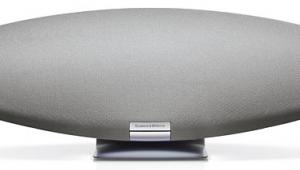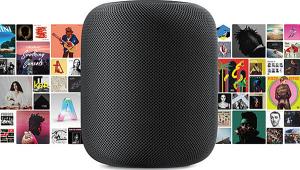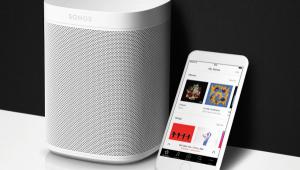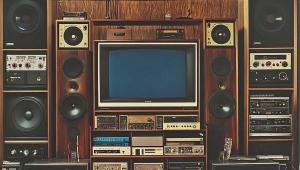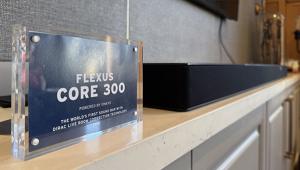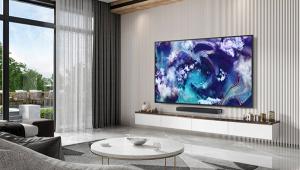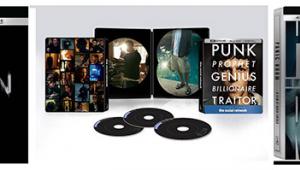The JBL L42ms review highlights its exceptional sound quality and sleek design, making it a standout choice for audiophiles seeking both style and substance in their audio equipment. It’s fantastic to see JBL continuing to innovate with such impressive offerings! - Wikily Tech
JBL L42ms Integrated Music System Review
AT A GLANCE
Plus
Rich, detailed sound for an all-in-one
Excellent build quality
Comprehensive connectivity
High-resolution audio support
Subwoofer output
Minus
No visual display
App is very basic
No S/PDIF input
THE VERDICT
The JBL L42ms is a music-focused integrated system that blends retro aesthetics with modern audio technology. Its simple design offers high-quality sound, ease of use, and useful features. It is a well-crafted, high-performance speaker that delivers audio satisfaction.
Clicking our links might earn us a commission—thanks for supporting Sound & Vision.
The JBL L42ms speaker system is a testament to JBL's ability to blend the charm of classic design with cutting-edge audio technology. Inspired by the iconic JBL L100 speakers from the 1970s, the L42ms is part of the company’s Classic Series and features an attractive wood veneer finish and JBL’s signature Quadrex foam grille.
 (Small).JPG)
Beneath its exterior lies a modern, compact audio powerhouse. The system comes equipped with a 24-bit/96kHz DAC, 200 watts of Class-D amplification, and comprehensive connectivity including Bluetooth, Apple AirPlay 2, and Google Chromecast. From its design and features to its performance and usability, it stands apart from the plastic competition.
Design and Build Quality
The JBL L42ms speaker system balances retro charm and modern minimalism. While the style evokes classic JBL designs, it still has a contemporary appearance characterized by clean lines and subtle curves that fits seamlessly into modern home decor. Although the smaller of two models in the series, it is still a rather substantial speaker.
Build quality of the L42ms feels robust and durable, akin to a premium standalone tower or bookshelf speaker. It is significantly more substantial than a typical soundbar. The L42ms measures 24-5/16”W x 6-11/16"H x 10-1/8"D and weighs 26.3 pounds.
The wood veneer finish is furniture-grade and available in Black Walnut and Natural Walnut. The curved front and angled baffle design is not merely an aesthetic choice, it contributes to acoustic performance by helping to widen the speaker’s dispersion and spread the soundfield.
 (Small).JPG)
The quality sound starts with its JBL-tuned drivers. The system is, in effect, a pair of quality bookshelf speakers, turned sideways with the tweeters on the outside, and fused together into a single unit. Thanks to (defeatable) DSP processing, the speaker offers an expansive stereo soundfield from one box.
The height and depth of this JBL are key qualities, with the 4-inch woofers contributing to its impressive audio performance. The catch to this design is that from a design perspective, there’s no choice but to use a relatively tall cabinet (as compared to a soundbar). That extra height makes the L42ms less than ideal for placing directly on a TV stand in front of a TV.
Due to its depth, wall-mounting is both technically and aesthetically challenging, as it sticks out and the ports are located in the rear. However, placing the speaker on a credenza beneath a wall-mounted TV is the ideal setup for this application. It offers a clean, aesthetically pleasing setup with more audiophile gusto than your typical premium all-in-one soundbar solution.
 (Small).JPG)
Keep in mind that JBL did not primarily design the L42ms to serve as a soundbar. After all, it is billed as a “tabletop-speaker system.” However, the speaker does have an HDMI ARC input, though it is limited to 2-channel PCM. So it is AV-friendly. JBL’s primary design goal is offering a high-fidelity speaker system that excels at music playback, something that is seldom a focus for soundbars.
Once connected via Wi-Fi the L42ms easily streams music from popular services like Spotify and Tidal directly using their respective Connect features. Apple users can enjoy seamless playback with AirPlay 2, while Chromecast built-in provides flexibility for Android and other devices, once you accept Google's terms in the JBL app or follow additional steps in the Google Home app.
The system is Roon Ready, offering high-resolution audio streaming and enhanced music management. This requires setup on a compatible device and the Roon Remote App. Additionally, the L42ms integrates with SmartThings for added convenience and smart home control.
If you are not concerned about pairing the speaker with a TV, it looks great placed almost anywhere. But picky listeners will want to experiment with placement for maximum audio fidelity—as you would with any stereo speaker system.
Audio
At the heart of the L42ms is a hi-res 24-bit/96kHz DAC capable of handling various audio formats, including FLAC, MP3, and MQA. The system specs claim 200 watts of power (total) with each of the two 4-inch pulp cone woofers receiving 75 watts and each of the two 0.75-inch aluminum dome tweeters receiving 25 watts. This configuration ensures a dynamic and full-range sound with low distortion across all volume levels.
The rated frequency response is 55-25,000 Hz (-6dB). JBL smartly equipped this speaker system with a subwoofer output, so you can turn it into a full-range rig for a modest additional investment.
The speaker includes a sound field expander (SFX) feature that enhances the width of the soundstage, although this can sometimes lead to a less focused audio presentation. The Bass Contour control switch found on the rear panel allows users to adjust the bass response based on the speaker's placement relative to walls and other surfaces, leaving it at 0dB when the speaker is far from a wall, otherwise it is recommended to use the -3dB setting.
Connectivity Options
The system is equipped with inputs and outputs to accommodate various sources. For wired connections you get stereo RCA and 3.5mm, HDMI ARC (for TV connectivity), an Ethernet port, and a USB-A slot (for service).
The Ethernet port and built-in Wi-Fi enable network connectivity. Additionally, the speaker offers Bluetooth 4.2 (ensuring compatibility with most wireless devices).
Controls
 (Small).JPG)
There are three buttons on a small control panel on top of the speaker. One is to cycle through the inputs (small icons light up to show which is selected) and the other two are for adjusting the volume. Technically that’s enough to get you by thanks to the system’s simplicity.
 (Small).JPG)
A Bluetooth remote control and the JBL Premium Audio app provide ways to manage the speaker. The physical remote offers playback control, direct input selection, volume adjustment/mute and a button to engage the sound field expander. Brief flashes of an LED light on the remote confirm that the speaker is receiving commands.
The JBL Premium Audio app is similarly minimalist. Since you can stream with Bluetooth or Chromecast or AirPlay, there's no need to set up the app with music services. Chances are whatever is running on your phone will work with the L42MS the moment it is found on the network or you pair it with Bluetooth. Still, the app does support Internet radio, podcasts, as well as Amazon Music, Spotify and Qobuz. But that’s about it, there are no settings to configure, just playback and volume controls for what's playing. Notably, the remote control offers control over playback when streaming.
Setup and Listening
Aside from the compactness and aesthetic simplicity, one of the main reasons you'd buy an all-in-one like this is the ease of setup. JBL does not disappoint. It keeps things really simple and so you don't have to fuss with firmware updates and logins or any of that nonsense to get things going.
Music
With a specified response of 55 Hz to 25 kHz, the L42ms delivers accurate sound across most of the frequency spectrum, though it benefits significantly from the addition of a subwoofer for enhanced bass impact and heft. Using a dual-opposed 12" subwoofer reaching down to 20 Hz, I transformed the L42ms into a full-range stereo system, providing coverage of the entire audible spectrum. Without the sub, the bass output is reminiscent of high-quality bookshelf speakers, focusing more on tightness and tonality rather than depth. The recording and genre determine if the JBL's output sound's "complete" or slightly lacking in the deepest bass notes. However, the standout feature of this system is its exceptional stereo imaging, which sets it apart from typical soundbars and affirms its legitimacy as a stereo system.
My listening tests involved music streamed via iTunes and AirPlay 2, as well as Tidal using Chromecast. Both services provided sufficient resolution to showcase the capabilities of the JBL system. Over the course of several weeks, I auditioned the system with and without the subwoofer, exploring a wide variety of music.
On its own, the L42ms excels with most genres. Classic rock staples like The Beatles' "Abbey Road" and Led Zeppelin's fourth album sound as they should on a good stereo system. Pink Floyd's "The Wall" and New Order's "Substance" also received the respect they deserve, presenting familiar tracks with clarity and precision.
A crucial part of my testing routine involves the "Tron: Legacy" soundtrack, particularly the track "Disc Wars," which combines the London Philharmonic Orchestra with Daft Punk's synthesizers. This track poses a challenge for many systems, and the L42ms was no exception. Adding a subwoofer was necessary to capture the full drama and impact of the track. Without the sub, the system struggled to convey the depth and power required, a recurring theme with modern electronic, hip-hop, and reggae dub music. Having used subwoofers in my system since 1992, I understand their importance in achieving a full-range sound.
Most speakers, including full-sized towers, benefit from the additional support. The JBL L42ms stands out in this regard, delivering impressive sound down to the crossover point and integrating seamlessly with the subwoofer, making it impossible to localize the sub and resulting in a cohesive overall sound.
Depending on the track, you might want a wider soundfield than what the system produces on its own. When activated, JBL’s sound field expander offers just the right amount of expansion to make listening more interesting while preserving the tonality of the music. Often this sort of expansion changes the character of the music, but here it is so seamless you can barely tell if it is on or off unless a track has stereo effects and a wide soundstage to show off in the first place. To test that I used tracks from The Orb’s Adventures Beyond the Ultraworld including the classic head-trip “Outlands” with its panning sounds that seemed to fly around the room freely.
While I wouldn't consider the L42ms to be a substitute for a full-sized stereo system, it comes close enough to that experience whereby in any situation that space is limited or where the convenience and aesthetics of an all-in-one system increase its appeal, this JBL fits the bill. Movies, Games and TV
I've already covered the caveats and qualifiers about how this JBL is not really a soundbar. But if you use it for AV, the truth is it is an excellent-sounding unit that offers exceptional dialogue clarity. You won’t get surround-sound or Atmos out of it, but with the subwoofer output you can easily hook up a monster sub—I tested it with an 18” Perlisten—and experience movies with impact that's almost as if you were in a theater. This was certainly the case when I screened Bad Boys: Ride or Die. With the sub, the crazy action scenes had all the impact you expect from an explosion and gunshot-filled Jerry Bruckheimer production.
Without a sub, movie sound is credible but not amazing. TV sound, on the other hand, is excellent even without a sub. For TV, dialog clarity reigns supreme, and to my ears the L42ms beats many soundbars for that quality.
 (Small).JPG)
I especially liked using the L42ms along with a projector, it only needs to be placed at the bottom of the screen and it’s good to go. The sound field expander comes in handy here, creating a surprisingly panoramic listening experience that appears to be wider than my 150” screen. The result sounds very natural, albeit not fully immersive like surround-sound.
This review coincided with the Paris Olympics, so I used the L42MS as the primary audio device while watching various competitions and found its performance impeccable.
Measurements
Using Room EQ Wizard and a UMIK-2, I ran several simple sinewave sweeps to check the in-room response and compare it to the published specs. I ran it with the "bass contour" control set to 0 and also -3dB. And I ran it with the sound stage expansion turned on and off.
The measured response exactly tracks what JBL promises. The -6dB point for bass was spot-on 55 Hz, rapidly rolling off below that. Without the expander on, the response was very flat and linear when measured nearfield. I did measure a -3dB dip in output centered around 5,000 Hz, which happens to be the crossover point, but that sort of highlights how linear the rest of the response is: tighter than your typical passive speaker. The sound field expander does warp the response curve, but this is expected with this sort of processing and as noted, it's not very audible in terms of its impact on tonality.
The -3dB bass contour setting performed as advertised, knocking down the bass output just enough to maintain neutrality when placed close to a wall. Lastly, I confirmed that an 80 Hz high-pass filter does kick in when you plug in a sub.
Conclusion
This may be an all-in-one speaker, but there is no such thing as one-size-fits-all when it comes to speaker systems. The L42ms is the right size for an urban apartment or condo living room system. Anywhere simplicity and an attractive design are among the priorities, along with high-fidelity.
The main thing I took away from this speaker is that it is a great standalone all-in-one, but that by adding a high quality sub, you get a rather amazing stereo. One that exceeds its price point and listener expectations. With a sub, it performs spectacularly for a device its size. That you can choose your own sub is a huge benefit over a typical soundbar. And what this says to me is JBL got the fundamentals right within the frequency range the speaker operates. That is why a well integrated sub takes the sound it makes to a higher level: the Lm42ms is playing its part perfectly.
The L42ms is a true testament to how adept JBL is at building a great-sounding speaker that speaks to the brand’s heritage without sacrificing performance. It is attractive, responsive, and easy to use and would be welcome in any room in my home.
Compact Integrated Music System Specifications
- Compact Integrated Music System
- Dual 4-inch (100mm) Pure Pulp white cone woofers
- Dual 0.75-inch (20mm) Aluminum dome tweeters with waveguides
- 200W RMS Class-D Total System Power
- 4-Channel Amplification with 75W RMS to each woofer + 25W RMS to each tweeter
- Configured for Stereo Reproduction
- 55Hz-25kHz (-6dB)
- 5kHz
- 102dB @ 1m
- Speaker placement boundary compensation
- Selectable Sound Field Expander (SFX)
- Autosensing with Auto-engage of 80Hz High Pass Filter
- WiFi streaming
- Bluetooth 4.2
- HDMI ARC
- RJ-45 Ethernet
- RCA Stereo Analog
- 3.5mm (1/8”) TRS Stereo Analog
- Streaming: 24-Bit | 32kHz/44.1kHz/48kHz/88.2kHz/96kHz
- Bluetooth: Up to 48kHz
- HDMI-ARC: PCM 2 Channel
- Version 4.2
- Profiles: SPP (Serial Port Profile), A2DP (Advanced Audio Distribution Profile), AVRCP (Audio/Video Remote Control Profile)
- Type: BTLE Wireless
- Black foam Quadrex grille
- Front-ported tabletop style cabinet available in black walnut or natural walnut furniture-grade wood veneer
- 6.4" x 24.3" x 9.2" (162mm x 617mm x 234mm)
- 26.3 lbs. (11.9kg)
- Unit of Measure: Each
- Gross Shipping Dimensions (HxWxD): 11.1” x 27.0” x 14.2” (283mm x 685mm x 360mm)
- Gross Shipping Weight: 34.3 lbs (15.6 kg)
- 100 - 240 VAC (+/-10%), 50/60Hz
- Log in or register to post comments


I have exactly the same one, only I had quality problems with it, I can't say for sure why, maybe it was defective, but I constantly interrupted the connection, I checked everything many times, it did not help, only one thing helped, this device to improve the connection saved me - ericsson 4418, I am very grateful to him for this, I was very scared!


